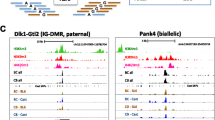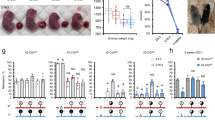Abstract
A subset of mammalian genes is monoallelically expressed in a parent-of-origin manner. These genes are subject to an imprinting process that epigenetically marks alleles according to their parental origin during gametogenesis. Imprinted genes can be organized in clusters as exemplified by the 2-Mb domain on human chromosome 15q11–q13 and its mouse orthologue on chromosome 7c (ref. 1). Loss of this 2-Mb domain on the paternal or maternal allele results in two neurogenetic disorders, Prader-Willi syndrome (PWS) or Angelman syndrome (AS), respectively. Microdeletions on the paternal allele share a 4.3-kb short region of overlap (SRO), which includes the SNRPN promoter/exon1, cause PWS and silence paternally expressed genes2. Microdeletions on the maternal allele share a 0.88-kb SRO located 35 kb upstream to the SNRPN promoter3, cause AS and alleviate repression of genes on the maternal allele4. Individuals carrying both AS and PWS deletions on the paternal allele show a PWS phenotype and genotype. These observations suggest that cis elements within the AS-SRO and PWS-SRO constitute an imprinting box that regulates the entire domain on both chromosomes. Here we show that a minitransgene composed of a 200-bp Snrpn promoter/exon1 and a 1-kb sequence located approximately 35 kb upstream to the SNRPN promoter confer imprinting as judged by differential methylation, parent-of-origin–specific transcription and asynchronous replication.





Similar content being viewed by others
References
Nicholls, R.D., Saitoh, S. & Horsthemke, B. Imprinting in Prader-Willi and Angelman Syndromes. Trends Genet. 14, 194–199 (1998).
Ohta, T. et al. Imprinting mutation mechanisms in Prader-Willi Syndrome. Am. J. Hum. Genet. 64, 397–413 (1999).
Buiting, K., Lich, C., Cottrell, S., Barnicoat, A. & Horsthemke, B. A 5-kb imprinting center deletion in a family with Angelman syndrome reduces the shortest region of deletion overlap to 880 bp. Hum. Genet. 105, 665–666 (1999).
Ohta, T. et al. Molecular mechanism of Angelman syndrome in two large families involves an imprinting mutation. Am. J. Hum. Genet. 64, 385–396 (1999).
Shemer, R., Birger, Y., Riggs, A.D. & Razin, A. Structure of the imprinted mouse Snrpn gene and establishment of its parental-specific methylation pattern. Proc. Natl Acad. Sci. USA 94, 10267–10272 (1997).
Birger, Y., Shemer, R., Perk, J. & Razin, A. The imprinting box of the mouse Igf2r gene. Nature 397, 84–88 (1999).
Blaydes, S.M., Elmore, M., Yang, T. & Brannan, C.I. Analysis of murine Snrpn and human SNRPN gene imprinting in transgenic mice. Mamm. Genome 10, 549–555 (1999).
Simon, I. et al. Asynchronous replication of imprinted genes is established in the gametes and maintained during development. Nature 401, 929–932 (1999).
Rougeulle, C., Cardoso, C., Fontés, M., Colleaux, L. & Lalande, M. An imprinted antisense RNA overlaps UBE3A and a second maternally expressed transcript. Nature Genet. 19, 15–16 (1998).
Wutz, A. et al. Imprinted expression of the Igf2r gene depends on an intronic CpG island. Nature 389, 745–749 (1997).
Kafri, T. et al. Developmental pattern of gene-specific DNA methylation in the mouse embryo and germline. Genes Dev. 6, 705–714 (1992).
Lee, J.T., Davidow, L.S. & Warshawsky, D. Tsix, a gene antisense to Xist at the X-inactivation centre. Nature Genet. 21, 400–404 (1999).
Acknowledgements
We thank B. Horsthemke for comments. The work was supported by the Israel Science Foundation-Centers of Excellence Program, the NIH (A.R. and H.C.), the Israel Ministry of Health (A.R. and R.S.) and the US–Israel Binational Science Foundation (H.C.). A.Y.H. was partially supported by a Foulkes Foundation fellowship.
Author information
Authors and Affiliations
Corresponding author
Rights and permissions
About this article
Cite this article
Shemer, R., Hershko, A., Perk, J. et al. The imprinting box of the Prader-Willi/Angelman syndrome domain. Nat Genet 26, 440–443 (2000). https://doi.org/10.1038/82571
Received:
Accepted:
Issue Date:
DOI: https://doi.org/10.1038/82571
- Springer Nature America, Inc.
This article is cited by
-
Imprinted DNA methylation reconstituted at a non-imprinted locus
Epigenetics & Chromatin (2016)
-
Expression of SNURF–SNRPN upstream transcripts and epigenetic regulatory genes during human spermatogenesis
European Journal of Human Genetics (2009)
-
Analysis of candidate imprinted genes in PWS subjects with atypical genetics: a possible inactivating mutation in the SNURF/SNRPN minimal promoter
Journal of Human Genetics (2007)
-
Identification of cis- and trans-acting factors possibly modifying the risk of epimutations on chromosome 15
European Journal of Human Genetics (2006)
-
Narrowed abrogation of the Angelman syndrome critical interval on human chromosome 15 does not interfere with epigenotype maintenance in somatic cells
Journal of Human Genetics (2005)





